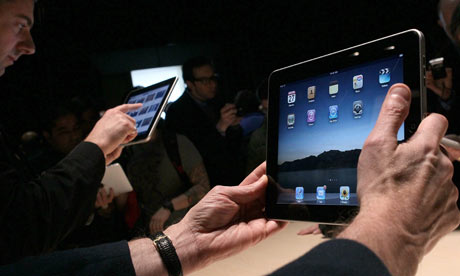Remember: the $$ were in the blades, not the razors
 I’ve always had a schizoid view of Apple: I’ve always liked Apple the company but disliked Apple the computer. But then again, Apple's really not in the computer business anymore, are they?
I’ve always had a schizoid view of Apple: I’ve always liked Apple the company but disliked Apple the computer. But then again, Apple's really not in the computer business anymore, are they?How can one not be a fan of the legend: a couple of west coast Second Wave boomers hook up for the usual 70’s slacking and start dabbling in mischief with the long distance phone-hacking devices that were the brief rage of that era. One drags the other to a meeting of a bunch of guys that built computers from kits, and the die was cast for a pioneer of the desktop revolution, with a company named as tribute to The Beatles.
But the real hook to this story is not only how the company is still standing thirty years later, but how it also made a couple detours – namely into music distribution and wireless devices -- each of which revolutionized their respective industries. Steve Jobs is already treated as an equal to Henry Ford in B-schools around the globe, and rightfully so. I buy into the whole thing.
But the hardware always left me with a different aftertaste. At its essence, the Apple II, Lisa, Mac or whatever was a closed system: a proprietary architecture with a proprietary operating system. Yes, such an approach makes for reliability and an easy to navigate --- if unremarkable --- upgrade, support and user environment.
But I thought this people’s revolution was about openness, collaboration, horizontally-integrated firms and user-generated innovation? After all, the early dogma of tearing down the private domains of the evil gatekeepers (Big Blue and its ilk) was pretty much contrary to what Apple seemed to be doing within its own chosen space. There lay my discomfort: hype vs. reality.
Which brings us to the Cult of the Mac, first cousins to the Trekkies. You know the rap: “I love my Mac, I hate Windows” and “it’s just sooooo much easier to use and it doesn’t crash” and so on. Of course, the closed architecture will generally deliver such advantages, but doesn’t anyone care about the downside to it? To that dedicated core, apparently not.
The result was a semi niche offering, which became a very good solution for media creation; be it in graphical, audio or visual forms. Just don’t try to use the Apple platform to toss those elements around the networks. Adoptees — the believers — then were the grinders that produced such media elements, while the hardcore developers, engineers and code jockeys dove into the Windows and (later) Open Source worlds, where men were men. Apple’s user base was easily satisfied by the spin and the image, which brings us back to the brilliance of Apple the company.
But that can’t really tee up a long-term, sustainable business, can it? No, it can’t; and it didn’t. Depending on the source, the figs report that Apple’s market penetration never hit double figures from ’90 onward; and its corporate penetration usually hovered in the two to four percent range.
But Jobs came to the rescue, although not with new and improved Macs. Instead, he went off the grid with a pure consumer play, and an unapologetic one at that. The iPod was launched, but while the world initially looked at it as an over-the-counter retail product (literally: go buy this thing at Target), the real vig flowed on the back end, via iTunes. Talk about printing money in the basement, here it was. V2.0 of Apple was born, and as a completely different animal. The transition was so extreme and redefining that investment analysts were often asking why they even bothered with the Mac business anymore.
Then along came v3.0, the iPhone Age. Another seismic shift, heralding another round of “oh yeah, this sure changes things.” Better still was the fact that v3.0 didn’t replace v2.0; it ran both in parallel and in conjunction with it. Want some tunes for that phone? Apple was suddenly something more than a comeback kid; it’s now a world power.
 So here we are now, staring at the iPad. Launched this week with his usual rock star buzz and fanfare, Jobs describes the ultra-thin, tablet-sized device as the biggest surprise ever from his bag of magic tricks. Now here the rest of the universe sits, a few days later, still pondering whether he’s right again or if maybe the King of the Hill has finally tossed a pitch into the dirt.
So here we are now, staring at the iPad. Launched this week with his usual rock star buzz and fanfare, Jobs describes the ultra-thin, tablet-sized device as the biggest surprise ever from his bag of magic tricks. Now here the rest of the universe sits, a few days later, still pondering whether he’s right again or if maybe the King of the Hill has finally tossed a pitch into the dirt.The consensus that seems to have emerged is one that paints the new device as something akin to an “iPhone on steroids”. But the opinion here is that such a view is missing the real thinking that is at work here from Mr. Jobs and his team.
First, let’s consider what it is not. It’s not a replacement for your phone; you’re not going to carry around an iPad to make a call as opposed to that iPhone in your shirt pocket or purse. So while there might be some application convergence (apps), there won’t be any device convergence at this level.
How about as a replacement for one’s computer? Specifically, is the iPad now the counter product to netbooks, especially given its display size and on-screen keyboard? Not likely, even if one buys the cloudy future, where little horsepower or data storage is required on the earth-dweller’s end. Sure, the IPhone apps model will see a new variation here feeding the iPad, but the heavy duty world of heavy duty web apps has never been one where Apple (and its architecture) has played well in. Here we are well into the cloud era, yet it is still very common to see “No Macs Here” when encountering SaaS solutions. For this and other reasons, I don’t agree with a few fortune tellers who are heralding the iPad as Apple’s long-sought key into the corporate enterprise.
Now that we know what it isn’t, then what is it? That answer becomes clear by simply looking at Apple’s recent modus operandi for that answer. In other words, follow the money and ask where it’s being made. The answer there is the aforementioned back end.
 Again: where is Apple’s music business making money, selling the iPods at the mall or 99 cents each for the downloads? Same thing on the iPhone side: compare the one time margins on the device sales compared to the perpetual cash machine that device becomes from that point onward. It’s the same thing with the iPad.
Again: where is Apple’s music business making money, selling the iPods at the mall or 99 cents each for the downloads? Same thing on the iPhone side: compare the one time margins on the device sales compared to the perpetual cash machine that device becomes from that point onward. It’s the same thing with the iPad.Jobs himself defined and proved the business model for digital music commerce. But what’s next on the plate? Video, of course: not only movies, television shows, cartoons, training and other pre-made titles, but also live and on the fly conferences, concerts, speeches, location cams and yes: one-on-one interactions. Granted, desktop monitors deliver those products, but not in a mobile or convenient manner. Smart phones are mobile and convenient, but insufficient and limited. Enter the iPad with one simple mission: to split that space.
Add to the mix the e-reader capability. One would guess that Mr. Jobs thinks that Mr. Bezos and Amazon is on to something with the Kindle, and has taken dead aim. Bring it on. Further add the IPhone apps that are crying for a larger screen and what you have is Apple basically saying “yeah we call it a tablet or whatever, but it’s really just a better way of displaying all this stuff y’all are showing us you want on a mobile platform.”
I’ll bet there are many, many Valley geeks that were involved in the 90’s versions of these things, banging their heads against their refrigerators this week while screaming "this is exactly what we were talking about!”
 So yes, the iPad is basically a portal; a portal to a full selection of songs, apps, videos and eBooks. Now guess where all those goodies will come from. Yes, the iStore and iTunes and associated spin offs. Yes, in near of full proprietary formats with limited transferability and digitally watermarked to keep them in the tight and closed Apple universe. It might be time for someone to turn that classic Apple 1984 ad on its head and have that woman toss her rage at an image of Steve Jobs. Better yet, have her son or daughter do it. Did you get that one, Google marketing?
So yes, the iPad is basically a portal; a portal to a full selection of songs, apps, videos and eBooks. Now guess where all those goodies will come from. Yes, the iStore and iTunes and associated spin offs. Yes, in near of full proprietary formats with limited transferability and digitally watermarked to keep them in the tight and closed Apple universe. It might be time for someone to turn that classic Apple 1984 ad on its head and have that woman toss her rage at an image of Steve Jobs. Better yet, have her son or daughter do it. Did you get that one, Google marketing? Taking inventory then, here is where we stand today’s Brave New (Apple) world: you’ll still need your phone (smart or otherwise) and you’ll still need your desktop or net/notebook. The question then is whether you have room in that tote for a new toy that nicely accommodates your desire for a new-gen media player of the highly mobile sort.
If yes, the logical next and more important question becomes one of just how many of you are out there and whether you all are something beyond the likely early adopters of gear heads, trendoids and teenage girls?
The jury’s out on just how earth shaking this announcement was. From here, it looks like a good read on market demand with a resulting product earmarked to better support that demand.
But I think I was looking for a little more of that convergence thing, like the way the iPod is melding into the iPhone. I was hoping to chuck another piece of hardware or two, instead of needing to add one more.
RM
3 comments:
What strikes me is the lack of Flash support.
Which further gives add'l support to your point.
you might be right
VERY GOOD
Post a Comment